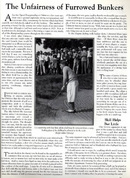I was perusing ebay and searching for items related to architect George Thomas when I stumbled upon a baseball signed by Hall of Famer "George Thomas Seaver," aka Tom Seaver, who was signing his legal name.
The late, Charlie Seaver, Tom's father, played a lot of golf during his teenage years with George Thomas at Los Angeles Country Club and also played a round with MacKenzie at Cypress Point. (When I interviewed him for The Captain, he told me had film of the MacKenzie round, though he did not want to have it transferred to tape at the time).
And for trivia buffs, Seaver was one win away from facing Bobby Jones in the final of the 1930 U.S. Amateur.
Anyhow, I'm presuming that Seaver named his son after Captain Thomas. And I know this makes your day!
Does anyone have any idea what Tom Seaver is these days?



















